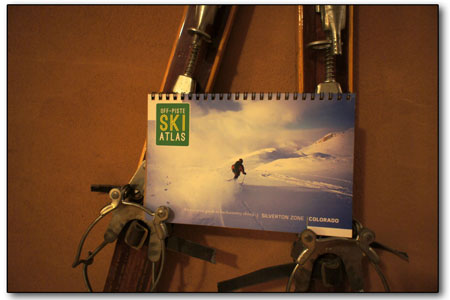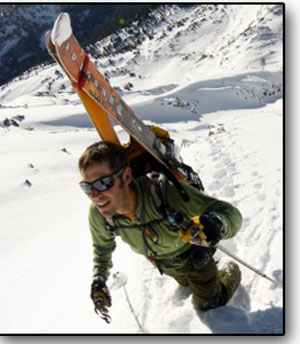
The second book in Andy Sovick’s “Off Piste Ski Atlas” series, the Silverton edition, hit stands last week. The book was a collaborative effort among several of Sovick’s friends and former ski partners./ Courtesy photo
Off the beaten path
FLC alum publishes second in backcountry skiing guidebook series
by Missy Votel
Much like the act of backcountry skiing itself, author Andy Sovick’s path from “big idea” to book was long, arduous and sometimes wrought with self doubt. But in the end, it was worth every step.
“It was so much fun, I decided to keep going,” said Sovick, a Fort Lewis College grad who recently penned the second in his backcountry skiing guidebook series, the Off Piste Ski Atlas - Silverton. The first guidebook, for the Crested Butte area, was published in 2013.
The 36-page (including cover) pocket-sized Silverton edition is waterproof, tear-resistant, lightweight and made of “Ultragreen,” a tree-free eco-friendly material. It hit shelves last week and is available locally at Backcountry Experience, Maria’s Bookshop and the Fort Lewis College Bookstore. If features beta on more than a dozen of Silverton’s most popular backcountry hotspots, as well as a comprehensive map, easy-to-read legend, trailhead and parking info, and sweeping aerial photos.
“I really want people to put it in their backpack, keep it in their car and let it get beat up,” said Sovick, who now lives in Gunnison with his wife, Gail, and 3-year-old son, Walker Joe.
Sovick, who graduated from FLC in 2004 with a degree in humanities, called upon the posse of ski buddies he formed while attending college to help make the dream of the book a reality.
“I had an awesome ski crew – there were about 15 of us that always went skiing together,” he said. “And like most backcountry skiers experiencing something for the first time, we felt like we were the first ones to discover these runs and we thought we should write a book.”
However, soon after the idea was hatched, the prospect of work called he and his future wife from the San Juans to Crested Butte. Instead, the honors of being the first one out of the group to write a guidebook went to another member – Brady Johnson, who moved to Driggs, Idaho, and wrote a book on the Tetons.
“He ended up doing it!” Sovick recalled. “We talked about it, but he did it.” Sovick was so impressed and inspired that he finally decided to follow suit. In 2010, he set to work on the Crested Butte book. And that’s when the slow upward slog began. For starters, in 2011, he and Gail moved down valley to Gunnison, where they started their family. In addition to getting settled in their new home, Sovick had to research the project, come up with a design and layout, and gather photos – all while holding down a day job as a timber framer. Of course, the ever fickle whims of mother nature had the final say when it came to the photo shoots, many of which were shot from via airplane. “It was a low winter, there was no snow,” Sovick recalled. “And then when there was snow, I realized there are a whole lot of conditions that have to be just right, like sun and no wind.” When everything was said and done, the book project was three years in the making.
“I felt like I needed all the elements to line up perfectly for it,” he said.
But the groundwork had been laid, and the Silverton book took only a year – that is, with a lot of help from his Durango posse. Josh Kling, owner of Kling Mountain Guides, served as liaison and consultant; photographer (and former Telegraph photographer) Steve Eginoire contributed the photos; and pilot Brad Soblosky, a ski patroller at Purgatory, flew the recon flights – to name a few.
 Author and self-professed ski and map geek, Andy Sovick./Courtesy photo |
And, of course, luck helped out as well. Sovick drove down to Durango in February 2013 to discuss the project, when a snowstorm was followed by a small window of brilliant bluebird skies. A quick call to Soblosky, and they were soon flying over the San Juans. “All the variables came together,” said Sovick. “It was the perfect day.”
But, as is often the case in the unforgiving San Juans, the luck was about to sour. With the aerial shoot finished, Sovick headed back to Gunnison the next day as another storm moved in. Little did he know, Eginoire – along with two friends – would be caught and injured in an avalanche near Silverton later that afternoon.
“It was really spooky,” said Sovick. “It really made me question the whole process.”
But that’s when, rather than turn around and scrap the whole mission, Sovick dug deep. “It actually helped with the guidance of the book,” he said. According to Sovick, the near miss resulted in an epiphany. “I really believe the backcountry is becoming more crowded,” he said pointing to such reasons as ultra-lightweight AT gear, better equipment, population growth and the explosion of backcountry skiing. “But we need to shift the discussion and not ask ‘how do we keep our stashes a secret?’ but ‘how do we keep our friends alive?’”
It was about the same time that Sovick learned about the American Institute for Avalanche Research and Education’s (AIARE) “Project Zero” campaign, which has the goal of zero avalanche deaths in the backcountry. “I got really excited about that. We’ve got to throw everything we’ve got at trying to keep people alive in the backcountry.”
To that end, Sovick’s book contains established skin tracks, preferred routes, etiquette, and notes on terrain traps, gullies and avalanche paths. It also assumes all users are trained in avalanche avoidance and rescue, and includes AIARE’s “Communication Checklist,” which includes tips for facilitating teamwork and good decision-making.
Sovick admits not everyone may be excited about a guidebook giving step-by-step directions to the doorstep of some of San Juan County’s favorite backcountry stashes. But so far, he said he has heard little backlash from either book, noting that the routes detailed are the “low-hanging fruit” – runs everyone already knows about.
“These are the easy pickings. I don’t feel like I spoiled anyone’s secret,” he said, adding that “crowded” by local standards is a relative term. “There’s still hundreds of thousands of acres out there. Just go a little farther beyond a lot of these runs, and you’ll find a quickly diminishing population.”
Rather, in Sovick’s opinion, the book, with its expansive aerial views, will help people see what not to do. “The aerial shots are a really important part of the book and what I feel is the most important thing to know for route-finding and safety,” he said. “The safest and smartest I travel is when I have a really good picture in my head of where I am. I really believe this guidebook will help the growing pains of the winter backcountry.”
To check out Andy Sovick’s guidebooks, go to: www.offpiste skiatlas.com
